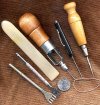K.V.:
Buy the books, buy the right tools, and do it the right way, just like anything else.
There's not going to be a lot of stress on the stitching in a sheath, usually. If you stitch the belt loop on the back, then you really ought to do it right.
You use a proper awl to make diamond-shaped holes for the thread. If you look at leather needles for sewing machines, these also make the diamond-shaped holes. The reason for this is to keep each stitch from lining up with the next one, so that the stress points aren't all in one line. It adds a little strength, and may add several years' life to the project.
Buy, build, beg or borrow a stitching horse (or a stitching pony) and that'll help keep everything lined up. Tandy has some 1 and 3 prong stitching pliers that'll punch the holes. I haven't tried them, but they look like they'd do a nice job on thinner leathers.
I've tried stitching damp leather once or twice, but I don't recommend it. Leather tends to have soft spots in it, and if it's wet when you pull your thread tight, you can pull the stitch right out, where you wouldn't have on dry leather. It just depends on the thickness of the leather and the stitch spacing. As stated, the stitching is about the last step, and few things are more frustrating than having to scrap something in the final stages.
Overstitch wheels come in 5, 6 and 7 stitch per inch spacing and only cost about six dollars apiece. I use these religiously, and people often want to know what kind of sewing machine I have. Done right, hand stitching outshines almost all machine stitching, not to mention the wonderful layer of calluses it builds on your fingers.

Like I said, the pocket of the sheath won't have much stress on it, so the method you use there isn't necessarily critical. If you develop good methods from the start, then you'll be in the habit when something critical does comes along.



